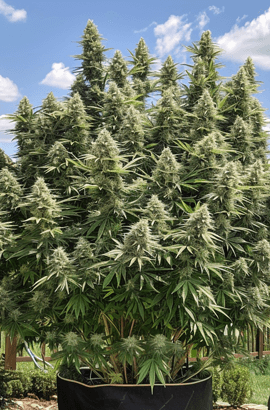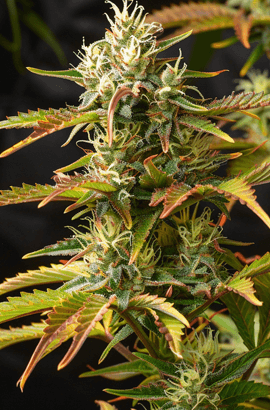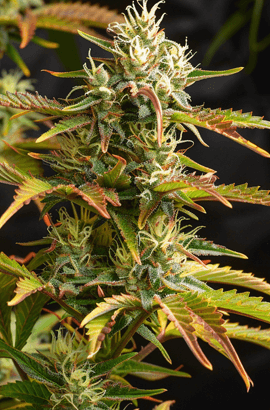
Kush Seeds
Kush seeds, particularly popular among cannabis growers, originate from the Hindu Kush mountain range and are celebrated for their robust characteristics and ease of cultivation. These seeds are typically indica-dominant, making them ideal for producing plants with strong, relaxing effects. Strains like OG Kush, Purple Kush, and Master Kush are renowned for their potent THC levels, often ranging from 19% to 26%, delivering both mental and physical relaxation.
Master Kush Seeds
$9/1 SeedOG Kush Seeds
$9/1 SeedStrawberry Kush Seeds
$9/1 SeedMango Kush Seeds
$9/1 SeedHindu Kush Seeds
$9/1 SeedStrawberry Kush CBD Seeds
$9/1 SeedCandy Kush Seeds
$9/1 SeedOG Kush CBD Seeds
$9/1 SeedCBD Kush Seeds
$9/1 SeedPurple Kush Seeds
$9/1 SeedLA Kush Cake Seeds
$9/1 SeedBubba Kush Seeds
$9/1 SeedBanana Kush Seeds
$9/1 SeedBanana Kush Autoflower Seeds
$9/1 SeedPurple Kush Autoflower Seeds
$9/1 SeedBubba Kush Autoflower Seeds
$9/1 SeedOG Kush Autoflower Seeds
$9/1 SeedCBD Kush Autoflower Seeds
$9/1 SeedLA Kush Cake Autoflower Seeds
$9/1 SeedExploring the Allure of Kush
Kush strains are celebrated for their distinctive earthy and piney aromas, often accompanied by subtle citrus notes. They are typically indica-dominant, providing relaxing and calming effects that are ideal for evening use. Kush plants are known for their dense, resinous buds and compact growth, making them a versatile choice for various growing environments.
Advantages of Growing Kush Seeds
- High Potency: Kush strains often feature high THC levels, ranging from 18% to 24%, delivering strong psychoactive effects.
- Resilient Growth: These plants are naturally resistant to common pests and diseases, making them easier to cultivate.
- Compact Structure: With their bushy growth, Kush plants are perfect for indoor cultivation or small outdoor gardens.
- Abundant Yields: Under optimal conditions, Kush plants can produce generous harvests of dense, resin-rich buds.
Starting Your Kush Cultivation Journey
Embarking on the journey of growing Kush seeds begins with successful germination. Here's how to get started:
- Soaking Method: Place your Kush seeds in a glass of water and let them soak for 12-24 hours. This softens the seed coat, promoting faster germination.
- Paper Towel Technique: After soaking, transfer the seeds to a damp paper towel. Keep the towel in a warm, dark place and check daily. Seeds usually sprout within 24-48 hours.
- Direct Soil Planting: Alternatively, plant the seeds directly into a potting mix. Keep the soil moist and warm, around 70-80°F (21-27°C), to encourage germination.
Setting Up Your Ideal Growing Environment
Creating the right environment is crucial for the thriving growth of Kush plants. Here's how to set up your grow space for optimal results:
Indoor Cultivation Tips
Growing Kush indoors allows for greater control over the environment. Here are some key factors to consider:
- Lighting: Use high-quality LED lights that mimic the full spectrum of natural sunlight. Kush plants typically require 18-20 hours of light per day during the vegetative stage and 12 hours during flowering.
- Temperature and Humidity: Maintain a temperature range of 70-85°F (21-29°C) during the day and slightly cooler at night. Humidity should be kept at 40-60% during vegetative growth, lowering to 30-40% during flowering to prevent mold.
- Air Circulation: Ensure good airflow with oscillating fans and an exhaust system to remove heat and moisture. This helps prevent mold and keeps plants healthy.
- Growing Medium: Choose a high-quality potting mix with good drainage. Adding perlite or vermiculite can improve soil aeration and water retention.
- Container Size: Use pots that allow for adequate root development. Fabric pots or containers with drainage holes are ideal to avoid waterlogging.
Outdoor Cultivation Tips
Kush can also thrive outdoors if provided with the right conditions. Follow these guidelines to maximize your outdoor grow:
- Sun Exposure: Position your plants to receive at least 6-8 hours of direct sunlight daily. Kush strains thrive in sunny, warm environments.
- Soil Preparation: Use nutrient-rich, well-draining soil. Enhancing the soil with compost or organic matter can boost fertility and support healthy plant growth.
- Watering Schedule: Water deeply but less frequently to encourage deep root growth. Let the soil dry out slightly between watering to avoid root rot.
- Pest Management: Regularly check for pests and use organic pest control methods, such as neem oil or insecticidal soap, to protect your plants.
- Climate Considerations: Plant Kush seeds in late spring or early summer in cooler climates to take advantage of the warm season. In hotter regions, provide some shade during the peak heat of the day.
Nourishing Your Kush Plants
Providing the right nutrients and water is essential for robust growth and high yields. Here's how to feed and water your Kush plants effectively:
Fertilizing Your Plants
Kush plants benefit from a balanced diet tailored to their growth stages. Here's what to consider:
- Vegetative Phase: Use a fertilizer rich in nitrogen to support leafy growth. Opt for an N-P-K ratio of approximately 3-1-2 during this phase.
- Flowering Phase: Transition to a fertilizer with higher phosphorus and potassium content to promote bud development. Aim for an N-P-K ratio of around 1-3-2 during flowering.
- Organic Options: Consider using organic fertilizers like compost tea, fish emulsion, or kelp meal for a more natural feeding approach. These options improve soil health and provide a steady supply of nutrients.
Watering Guidelines
Proper watering practices are crucial for the health of your Kush plants. Follow these tips for effective watering:
- Frequency: Water when the top inch of soil feels dry. It's better to underwater slightly than to overwater, as overwatering can lead to root rot.
- Water Quality: Use filtered or dechlorinated water to avoid chemical build-up in the soil. Adjust the pH of your water to between 6.0-7.0 for soil grows, and 5.5-6.5 for hydroponics.
- Deep Watering: Water thoroughly to ensure moisture reaches the deeper roots. Allow excess water to drain away to prevent soggy soil conditions.
Advanced Growing Techniques for Kush
Enhance your Kush cultivation with these advanced training techniques:
Implementing Low-Stress Training (LST)
Low-Stress Training (LST) involves gently bending and securing branches to create an even canopy. This technique improves light distribution and promotes the growth of multiple bud sites. Use soft plant ties or garden wire to secure the branches without causing damage.
Exploring High-Stress Training (HST)
High-Stress Training (HST) techniques like topping and fimming involve cutting the main stem or branches to promote bushier growth and more bud sites. Topping removes the main growth tip to encourage two new main colas, while fimming leaves a portion of the tip to create multiple new growth tips. These methods can significantly increase yields but should be done early in the vegetative stage to allow the plant to recover before flowering.
Utilizing the Screen of Green (ScrOG) Method
The ScrOG technique uses a screen or net to train plants horizontally, maximizing light exposure to all parts of the plant. This method is especially effective for Kush strains, which benefit from increased light penetration. Place the screen about 8-12 inches above the growing medium and weave the branches through the screen as they grow, creating an even canopy. This setup supports heavier buds and improves overall yield.
Pest and Disease Control for Healthy Kush Plants
Maintaining a healthy environment for your Kush plants is crucial to prevent pests and diseases. Here are some tips to manage common problems:
- Aphids and Spider Mites: These tiny pests can weaken plants by sucking sap from the leaves. Regularly inspect your plants and use organic insecticides like neem oil or insecticidal soap to control infestations. Introducing beneficial insects like ladybugs or predatory mites can also help keep these pests under control.
- Powdery Mildew: This fungal disease appears as a white, powdery coating on leaves and can thrive in high humidity. To prevent mildew, maintain proper humidity levels and ensure good air circulation. If mildew is detected, remove affected leaves and treat the plant with a fungicide or a mixture of water and baking soda.
- Root Rot: Overwatering and poor drainage can lead to root rot, which can severely impact plant health. Use well-draining soil and containers with adequate drainage. Allow the soil to dry out between waterings and avoid overwatering. If root rot occurs, trim away the affected roots and replant in fresh, dry soil.
- Bud Rot (Botrytis): Bud rot is a gray mold that can devastate flowering plants, especially in humid conditions. Keep humidity low during the flowering stage and ensure good airflow around the buds. Remove any affected buds immediately to prevent the spread of the mold.
Harvesting and Curing Your Kush Cannabis
Proper harvesting and curing are essential to maximizing the potency and flavor of your Kush buds. Here's how to ensure a successful harvest:
Determining the Right Harvest Time
Kush plants are ready for harvest when the majority of the trichomes (the tiny, crystal-like structures on the buds) have turned from clear to milky white, with some turning amber. This usually occurs 8-10 weeks into the flowering stage. Use a magnifying glass or microscope to inspect the trichomes closely for optimal harvest timing.
Harvesting Process
To harvest, cut the main stem at the base of the plant. Trim away the larger fan leaves, but leave the smaller leaves surrounding the buds. Hang the branches upside down in a dark, well-ventilated space with temperatures around 60-70°F (15-21°C) and humidity levels of 50-60%. Allow the buds to dry for 7-10 days until they feel dry to the touch but still slightly springy.
Curing for Optimal Quality
After drying, place the buds in airtight glass jars. Open the jars daily for the first week to release excess moisture and prevent mold. Continue curing for 2-4 weeks, opening the jars less frequently as time progresses. Proper curing enhances the flavor, aroma, and potency of your Kush buds and significantly improves the overall quality.
























